Follow the Raptor Migration
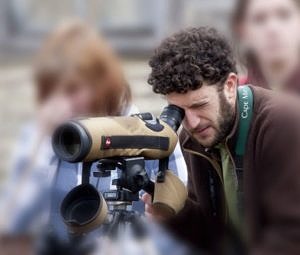
Harris Center Bird Conservation Director Phil Brown uses a spotting scope to get a better view of passing raptors.
Biologists regularly record up to 15 different raptor species from platform at the Pack Monadnock Raptor Observatory. From mid-September through mid-October, significant daily and seasonal flights of Broad-winged Hawks, Sharp-shinned Hawks, Northern Goshawks, Peregrine Falcons, Ospreys, and Bald Eagles are possible. Mid-October through mid-November often brings Golden Eagles and Northern Goshawks.
During the migration season, detailed reports — including hourly raptor count and weather data, non-raptor observations, special notes, season totals, and next-day forecasts — are posted at the end of each day on hawkcount.org, an online database managed by the Hawk Migration Association of North America (HMANA). Historic migration data are also available via hawkcount.org, and you can find annual summaries of Pack Monadnock migration data from recent years here. Hawk Watch Coordinator Phil Brown also provides regular in-season updates below.
The Pack Monadnock Raptor Observatory is a project of the Harris Center for Conservation Education, in partnership with the State of New Hampshire Department of Natural and Cultural Resources, Division of Parks and Recreation. It was founded by New Hampshire Audubon.
Updates from the 2023 Season
Season Summary 2023
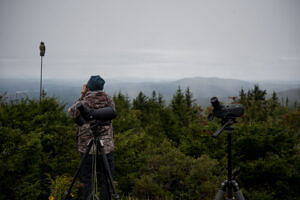
Levi Burford watches for hawks on a cloudy day atop Pack Monadnock. (photo © Ben Conant)
On November 20, Harris Center raptor biologist Katrina Fenton and several volunteers closed out the 19th season of the Pack Monadnock Raptor Observatory. She described the scene eloquently:
“What there was for clouds mostly stayed far to the north and west, blocking Mount Washington from view but also providing a nice backdrop for spotting lower birds. A sprinkling of last night’s snow pooled in gently cupped oak leaves and finely dusted the upper parts of the mountain. It melted quickly from the platform under toe-warmer-filled boots.”
In Pack’s 19th season, the effort and hours were consistent with past years, visitors numbered 5,784, and a total of 13,058 migrating raptors was tallied by our team of staff and volunteers. A raptor release in September, Big Sit in October, and Big Soup in November were among the season’s more memorable public events. Four big Broad-winged days in September with over 1,000 birds each day pushed the total for this species to over 10,000 for the season – a landmark number and among the highest in the count’s history. Sharp-shinned Hawks recovered well from last year’s low tally, and Merlins continued to increase. However, low tallies of Osprey, American Kestrel, and American Goshawk furthered the conservation concerns we share about these species in the Northeast.
Species Trends
Below is a brief species-by-species summary of the 2023 season:
– Black Vulture – 3 – RECORD HIGH and third straight year counted
– Turkey Vulture – 286 – settling into average territory and much lower than in recent past years
– Osprey – 122 – for a second straight season, this year’s total is the lowest year since the beginning of the count in 2005. Competition with Bald Eagles seems to be a driver of a declining interior migrant Osprey population.
– Bald Eagle – 196 – slight drop from last year, but still well above long-term average. Perhaps the impacts of avian flu are leveling off an otherwise recovering population.
– Northern Harrier – 90 – about average. Our observers aged this species too.
– Sharp-shinned Hawk – 1198 – a big rebound year for “Sharpies” which came in low in 2022. Long-term declining trend for this smallest of our raptors.
– Cooper’s Hawk – 167 – ticked upward into above-average territory.
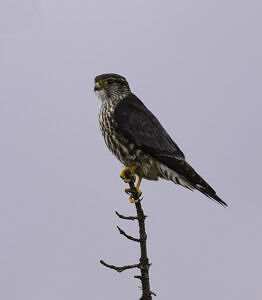
A Merlin, perched atop a tree on Pack Monadnock. (photo © Chuck Carlson)
– American Goshawk – 6 – record low by a long shot; a dramatic decline from last year’s 22. Widespread concerns about their decline are prompting further regional monitoring efforts.
– Red-shouldered Hawk – 188 – way down from last year’s record-setting 301 but still above the long-term average. Perhaps colder temps coming later is keeping them north a bit longer than usual.
– Broad-winged Hawk – 10,256 –an above average season and just the 4th time we’ve broken the coveted 10,000-mark for this abundant early migrant.
– Red-tailed Hawk – 212 – this continues the steady decline the we’ve been observing at Pack Monadnock. The finger of suspicion points at a decreased number of migrants and not a decreasing population.
– Rough-legged Hawk – 1 – a dark-morph bird picked up on 10/16 by Iain MacLeod.
– Golden Eagle – 10 – a near-average tally of this uncommon eastern migrant.
– American Kestrel – 92 – a record-low for the modern era. All the more reason to stay focused on local American Kestrel conservation efforts like the one the Harris Center is leading.
– Merlin – 108 – still increasing; first time Merlins outpaced Kestrels at Pack.
– Peregrine Falcon – 61 – a strong showing for our largest falcon.
Non-Raptor Highlights

A Gray Catbird. (photo © Meade Cadot)
2023 brought a diversity of birds to the Observatory, with more than 100 total species recorded. Highlights included Townsend’s Solitaire, Black-bellied Plover, Brant, Snow Goose, Bohemian Waxwing, and surprisingly for the site, Gray Catbird. It was also a decent irruption year for finches with strong showings of Pine Siskin, Red Crossbill, White-winged Crossbill, and lower numbers of a few others.
We also count Monarch butterflies, recording a low number of 299 this season.
All bird data were entered into eBird.org and, like the raptor migration data, are available to scientific analysis as well as the general public. Raptor migration data are also available at hawkcount.org and are provided to the Raptor Population Index for long-term analyses and periodic raptor population trend estimates.
Thank You
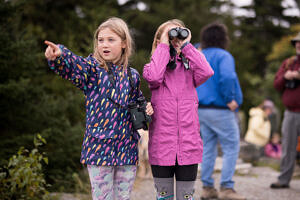
Two young birders watch for hawks at the Observatory.
(photo © Ben Conant)
We thank you – our sustaining donors, partners, supporters, volunteers, observers, and readers – for following the migration with us this season, and for enabling us to continue our important dual mission of educating the visiting public about raptors and contributing vital data to international raptor population monitoring efforts.
A big thanks to Miller State Park and their staff for hosting us and making everyone feel welcome at the park. For an in-depth season summary, check out our Annual Report, which provides an in-depth season summary, species analyses, a complete avian species list, and more. We look forward to seeing you again for our 20th season in 2024!
10,000 Broad-wings in September!

A Broad-winged Hawk juvenile soars over the Observatory on September 14, 2023. (photo © Tom Momeyer)
An above average tally of over 10,256 Broad-winged Hawks (and the highest since 2016) was noted this fall at the Pack Monadnock Raptor Observatory, comprising 83% of migrant raptors tallied here so far. Among these were an astounding 6,820 counted during International Hawk Migration Week, a celebration of global raptor migration under the umbrella of our partner organization, the Hawk Migration Association of North America. Relatedly, two female Broad-wings – Nubanusit and Skatutakee, are still being tracked by the Harris Center’s and Hawk Mountain Sanctuary’s long-term research project focused on the full-life cycle of this familiar summer species. To see where these birds are now, check out Hawk Mountain’s bird tracker.
Raptor Release & School Programs
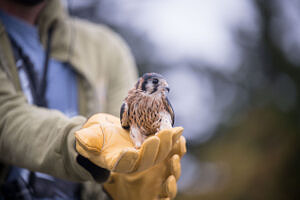
Phil holds a rehabilitated American Kestrel, ready for release. (photo © Ben Conant)
Area schools continue to make the Observatory a prime destination for witnessing and learning about the spectacle of raptor migration. From pre-schools to graduate schools and everything in between, hundreds of students have interacted this season with our raptor educators or biologists. Over a dozen children were among those who enjoyed the release of four rehabilitated birds of prey brought to us by Wings of the Dawn in Henniker, New Hampshire, on September 24. Two American Kestrels and two Broad-winged Hawks enjoyed a second chance at freedom as Harris Center staff and Wings volunteers displayed and released these birds into the wild. Check out some more pictures of the release on our Flickr account.
Sharpies Spike in Mid-October
Though October often lacks the numbers of Broad-wings that September brings, this spectacular and colorful month has many highlights. As I write this, foliage season is still at peak and has been slowly transitioning from reds to oranges and yellows over the past few weeks. Even the bright white summit of Mount Washington, capped with fresh snowfall, has come into view on these crisp mid-October days!
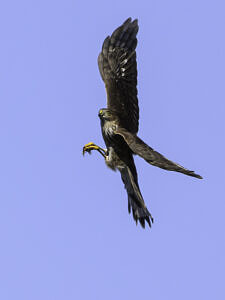
A “Sharpie” engages in mid-air antics over the Observatory. (photo © Chuck Carlson)
Back to raptors, it’s been a month for Turkey Vultures, falcons of all three species, and Sharp-shinned Hawks, our second most numerous migrating raptor species. Nearly 500 (around half the season’s total) have passed this month alone, marked by three consecutive days of 80+ individuals in mid-October. ‘Sharpies’ as they are affectionately known as, are (despite their diminutive size) among the most visible raptors most days, and they migrate throughout the entire season. Their feisty antics and ferocious dives on larger raptor species – including Bald Eagles – have earned them the reputation as one of the
toughest raptors. ‘Gina’, the plastic owl that keeps watch over the Observatory platform, is no stranger to brushes with fierce Sharp-shinned Hawks, which often come in for a closer look with talons out as they also terrorize the local junco flock. Our work monitoring this species’ long-term population decline plays a key role in documenting their decline and setting the stage for further conservation and research actions. Other species whose migration counts have been falling at Pack and in the Northeast in the most recent decade include Northern Harrier, American Kestrel, and Osprey.
Get Ready for Goldens and Goshawks!

This Red-tailed Hawk’s namesake is on full display. (photo © Carl Jenisch)
Now and into early November is peak season for some of the later raptor species which move south through our area in smaller numbers each year. It’s the time to bundle up and join us as we search the skies for the uncommon American Goshawk and rare Golden Eagle, several of which are seen each season. The season’s surprise was another rare late migrant – a dark-morph Rough-legged Hawk – which site founder and volunteer Iain MacLeod located soaring past the watch on October 16. In addition to this rare Buteo, the last part of the season is THE time to witness big days of Red-tailed and Red-shouldered Hawk migration. The days following cold fronts are excellent ones to hedge your bets on if you’re hoping to strike gold!
Auto Road Hours
As the days shorten, our partner and host site, Miller State Park, has shortened its hours for keeping the auto road open to vehicle traffic. The gate now closes at 4 p.m., and the road will be closed for the season after November 11. Bear in mind that snow or freezing rain at elevation may also close the road. So be sure to plan your visit accordingly and make a reservation on the park’s website as you join us in the last weeks of the season.
Thank You to Our Supporters!
The Harris Center’s Pack Monadnock Raptor Observatory is supported by private and community donations, grants, and foundations. Thanks to those who have made a gift to keep our biologists counting for a 19th consecutive season and our educators sharing the science and magic of raptor migration with all who visit. To contribute today, visit our Donation page and select Pack Monadnock Raptor Observatory.
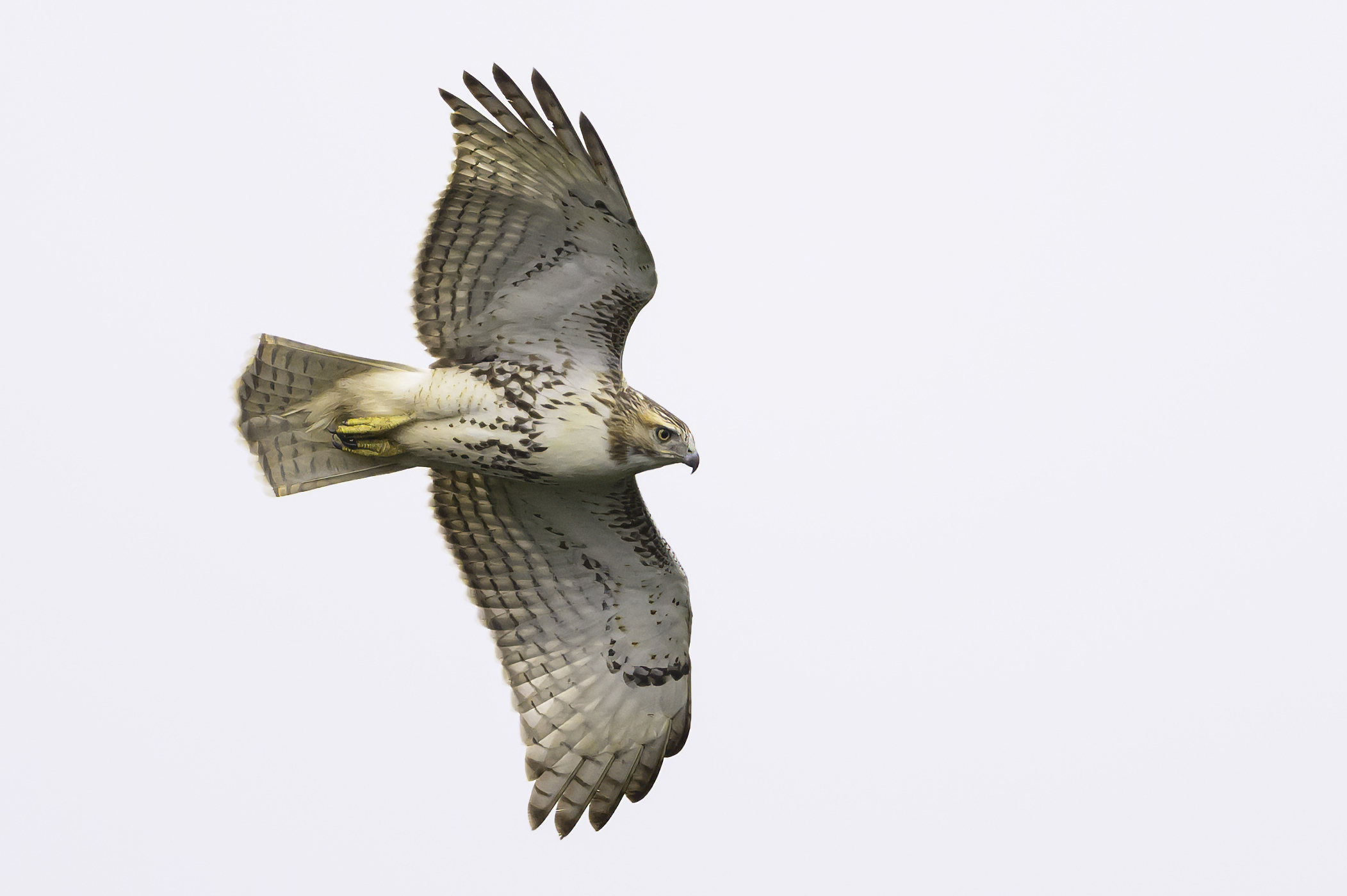
A Red-tailed Hawk soars over Pack Monadnock in late September. (photo © Chuck Carlson)
Off To a Slow Start
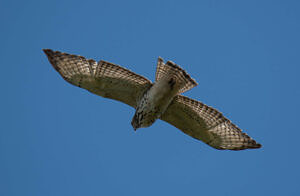
A Broad-winged Hawk in flight over the Pack Monadnock Raptor Observatory. (photo © Judd Nathan)
After the slowest start in the project’s 19-year history, owing to the lengthy stagnant weather pattern of hot and humid days, the migration floodgates finally broke open today! Just a few days behind schedule, hundreds of Broad-winged Hawks and a number of other species began their southbound movements past the Pack Monadnock Raptor Observatory, dazzling several dozen onlookers. Broadwings, the species that comprise 75% of the annual count, will pass in large numbers for the next week or two, and several other species will reach the peak of their migration in our area. Cooler days like today with light northwest winds are best for migration conditions, and the following week — with the exception of Saturday’s forecasted high winds — should facilitate plenty of good migration over Pack.
Other raptor species migrating through in numbers now include Osprey, Bald Eagle, Sharp-shinned Hawk, Merlin, and American Kestrel. It’s also peak migration season for warblers, and Monarch butterfly tallies have been steadily increasing. There’s plenty to enjoy in mid to late September at the Observatory. Check out all the latest reports here.
Mark Your Calendars
On Sunday, September 24 at 1 p.m. sharp, the Harris Center and Wings of the Dawn are planning a raptor release at the Observatory. Plan ahead and reserve your spot with Miller State Park that afternoon, and keep in mind that parking may be full at the summit on busy weekend days such as this one.
And, a last-minute reminder that I’ll be giving a Zoom presentation on the Raptors of Pack Monadnock with a focus on identification tonight at 7 p.m. I hope to ‘see’ you there!
Wishing you a good migration season!
Gearing up for the Hawk Watch
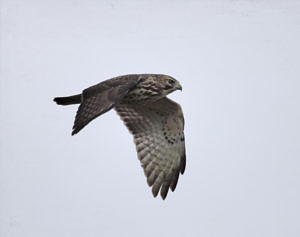
A Broad-winged Hawk in flight.
(photo © Andre Moraes / raven.digital)
On Friday, September 1, we’ll begin our 19th consecutive season of monitoring migrating raptors and educating visitors at the Pack Monadnock Raptor Observatory.
Miller State Park and the NH Department of Natural and Cultural Resources remain our hosts and partners. As always, the Observatory relies on various funding sources, including private contributions – so thanks in advance for your continued support of this important conservation research and education project.
In 2023, the Observatory welcomes Levi Burford and Katrina Fenton as Seasonal Raptor Biologists and lead counters five days per week (Wednesday through Sunday). Volunteers Iain MacLeod (Mondays), Julie and Phil Brown (Tuesdays), and a combination of several other longtime observers will round out our lineup.
We’re gearing up for a couple of events – a Migratory Raptors of Pack Monadnock Zoom program on September 14 and the Big Sit on October 7. Otherwise, it will be business as usual, and we welcome all to come learn about the science and spectacle of migration with us!
The Observatory is staffed every day, weather permitting, from September 1 through November 20. While the Hawk Watch is free to visit, as always, reservations for Miller State Park are strongly recommended to guarantee your space on the mountain. Check out our Visiting the Hawk Watch page to plan your trip.
Contact Us
For more information on the Pack Monadnock Raptor Observatory or to volunteer, please contact Bird Conservation Director Phil Brown.

